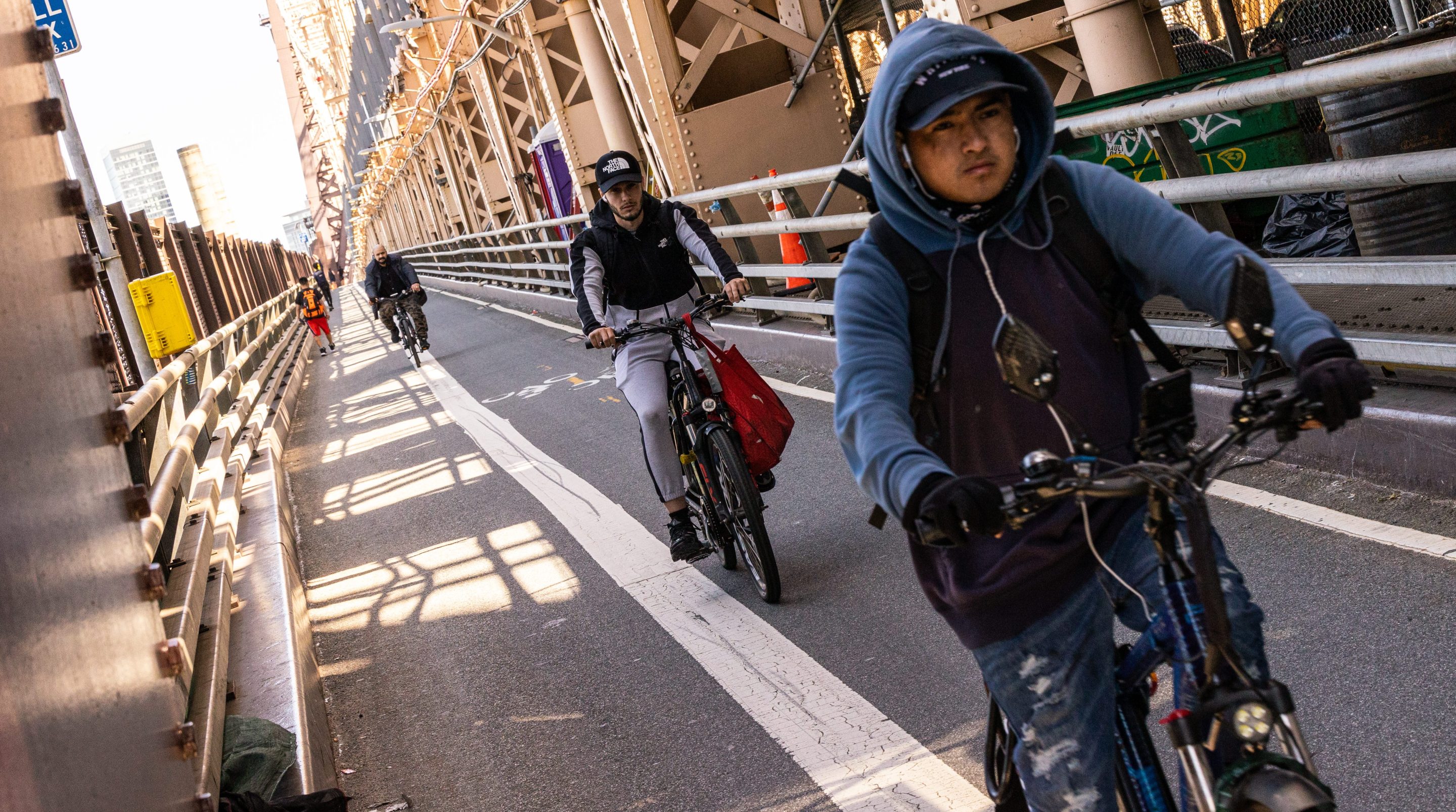City Hall deflected responsibility Tuesday for this year's record-setting cyclist death toll — insisting that e-bike riders are to blame for the rise, trotting out new number crunching that officials had never previously released.
In response to an unrelated question on Tuesday about the mayor's approach to street redesigns, Deputy Mayor Meera Joshi chimed in that e-bikes are "driving" the increase in cyclist deaths to a record 26 so far this year.
"For the last three years, e-bikes have been a larger source of our fatalities year-over-year and this year, 70 percent of our fatalities are ... Involving e-bikes," Joshi said.
"I don't want to lose sight of the fundamental reason why [we redesign] streets in the first place. It's for safety, and when we look to improve safety, we have to look at what's driving it today," she added. "Today we're seeing the illegal mopeds and scooters and motorcycles and e-bikes."
Mayor Adams concurred, taking the opportunity to bemoan battery-powered bikes, which the state legalized in 2020.
"We have an e-bike/moped/illegal moped crisis," Hizzoner said. "We need to address the over-proliferation of e-bikes [and] scooters.
"We don't want to be heavy-handed in enforcement, but we have to get this e-bike/scooter delivery under control, because it's not under control now,"
Pressed for the underlying data, Department of Transportation officials provided just three years of figures from 2021, 2022 and 2023 — which showed the portion of cyclists killed on e-bikes dropped from 57.9 percent two years ago to 47.4 percent last year and rose to 69.2 percent this year to date. Such a statistical analysis was not previously released to reporters before the Adams administration.
Overall, 18 of this year's dead cyclists were e-bike riders, compared to 11 in 2022 and 9 in 2021, the city said, but because officials previously did not separate e-bike deaths from general cycling fatalities before two years ago, it is impossible to gauge the historical significance of recent trends. Crucially, DOT could not provide the raw number of trips made on e-bikes vs. manual bikes, rendering it impossible to determine the true extent of the "crisis."
Joshi also emphasized the importance of redesigning streets to "accommodate" the increasing numbers of e-bikes, which she called "a good, green transportation method that has been used recklessly sometimes and is unfortunately really driving some of the fatalities that we're seeing on our streets."
This year is on track to the be the deadliest year for cyclists since 1999. The last year that was nearly this bloody for two-wheelers was 2019, when 28 cyclists were killed over the full 12 months. It's unclear what portion of either year's dead were e-bikers, since the city did not track those figures at the time.
NEW DATA: In the first nine months of 2023, traffic violence killed 183 New Yorkers.
— Transportation Alternatives (@TransAlt) October 17, 2023
➡️ Drivers of cars, trucks & other large vehicles caused 99% of pedestrian fatalities.
➡️ NYC is on track to have the deadliest year for bike riders since 1999.
We demand action now. pic.twitter.com/fklZuPUTyA
But the high proportion of e-bike users among this year's cyclist victims only tells part of the story, according to advocates. A higher proportion of the year's dead — 94 percent — died on streets without protected bike lanes, which the city has failed to roll out at the pace the mayor promised when he got elected.
"All bike riders deserve to be safe on our streets, whether they're riding an e-bike or a traditional bike," said Elizabeth Adams, deputy executive director for public affairs at Transportation Alternatives.
"The vast majority of bike riders were killed by drivers of cars and trucks — and 94 percent of those fatalities took place on streets without protected bike lanes," she added. "Building protected bike lanes keeps everyone safe — bike riders, pedestrians, and drivers. Yet just 3 percent of our city's streets have a protected bike lane."
E-bikes have been present on city streets for years even before they were legalized in 2020. That year coincided with a dramatic increase in cycling across the city during the start of the COVID-19 pandemic which has continued to this day — further muddling the significance of Joshi's e-bike stat.
“It’s not a new condition. E-bikes have been with us for a number of years now," said Jon Orcutt, a former city transportation official and longtime bike advocate. "There's a huge safety problem in the bike lanes and in the curb lanes in New York City. It’s people getting killed on two wheels.”
Orcutt castigated DOT for not doing the work to decipher the acute causes of each crash. For example, while the agency has repeatedly noted that six of this year's bike victims were killed in "solo" crashes, it has not provided any additional details that would allow for a policy response to those crashes.
“What are the nature of these crashes? We don’t know if they hit a crack or a hole, or were going through a light," Orcutt said. "DOT isn’t doing any detailed release to summarize what the crash reports show."






